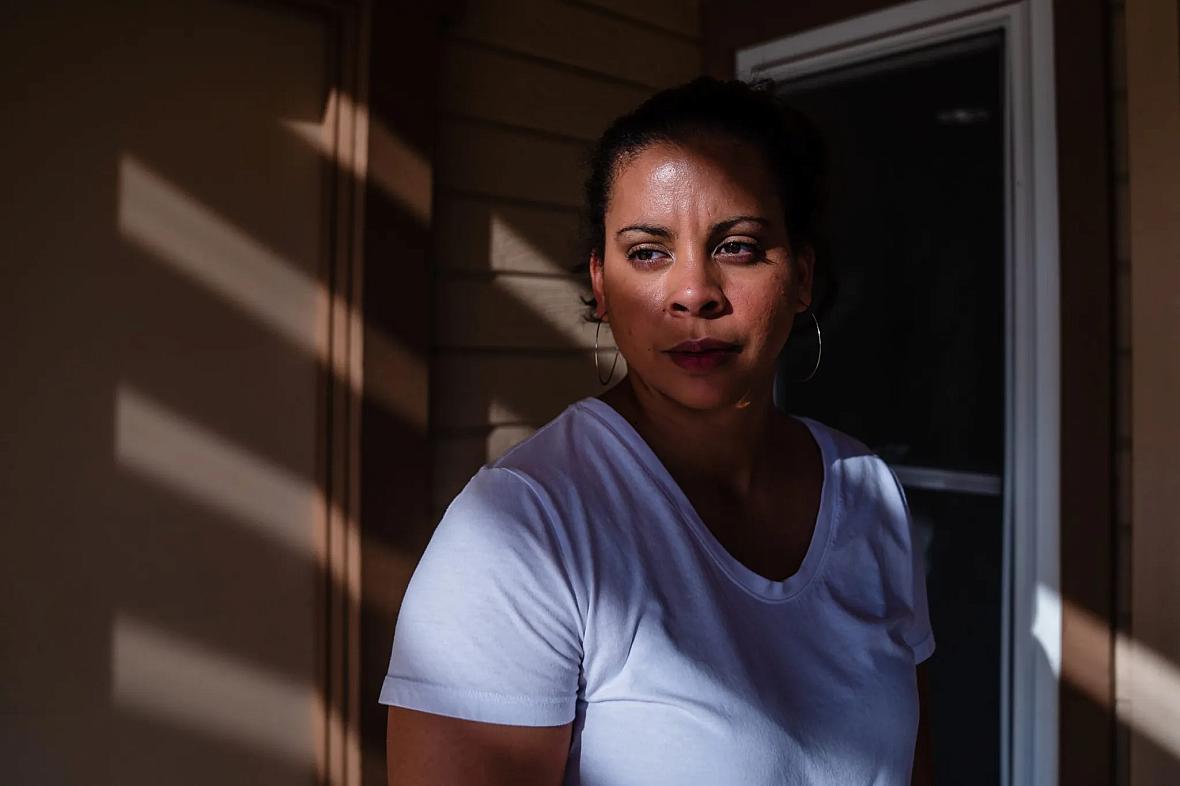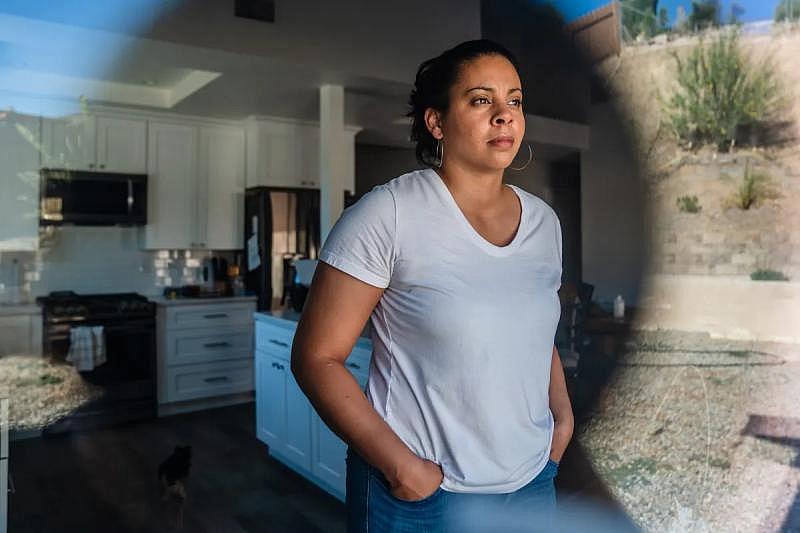Women In Military More Than Twice as Likely to Die By Suicide as Civilians
This story was completed as a project for the USC Annenberg Center for Health Journalism 2021 Data Fellowship.
Other stories include:
Young Men in Military Almost Twice as Likely to Die By Suicide as Civilian Peers
Over Six Years, There Have Been More Than 30 Suicides at Camp Pendleton

Jalitza Cardona in Santee, California on June 28, 2022.
Photo by Ariana Drehsler for Voice of San Diego
If you or someone you know might be considering suicide, there is help. Call or text 988.
Life in the Navy, for Jalitza Cardona, felt like a relentless march of awful events.
Cardona’s mother had served a full 20 years in the Navy. When Cardona finished high school, she didn’t see much opportunity in front of her. And so she, too, became a sailor.
While Cardona was still in training to become a ship’s mechanic, during a night of heavy drinking, another sailor sexually assaulted her, she said. She told her chain of command, but the sailor was cleared of wrongdoing during an official proceeding.
“From that moment on, I just snapped,” she told me. “I was like, ‘Okay, there really is no justice in the world.'”
Anger, frustration and pain began to grow inside her. They turned into depression. She worked in a small unit with few other women.
“If you weren’t pulling your weight, they would let you know it,” she said.
The depression made it nearly impossible for her to get out bed at times. Her shipmates saw she was struggling mentally – and taunted her.
They called her crazy and told her to “Go take your medication.”
These confrontations started leading to outbursts. Down in the bowels of the USS New Orleans, Cardona threw wrenches at other sailors and screamed at them to “Fuck off.”
As her professional life unraveled, Cardona looked to romantic relationships to save her from pain and insecurity, she said. She moved in with a boyfriend, another sailor with whom she had an on-again, off-again relationship. He eventually ended the relationship for good.
Cardona felt alone, standing in the middle of an unbroken darkness.
Today, she is thankful that when she took a handful of pills, they did not bring about what she intended.
Jalitza Cardona at Santee Lakes Recreation Preserve in Santee, California on June 28, 2022. / Photo by Ariana Drehsler for Voice of San Diego
She faced a long climb out of depression. Eventually she found patches of light. She began to recognize what had been unhealthy in her past relationships. She went to therapy with other vets. And she started working in therapy herself.
“I have a lot of what I didn’t have in the military. A lot of things that were stolen from me I’m getting today – like brotherhood, a sense of community, a mission, a purpose,” she said. “Those are things I’m actually experiencing today, but not when I was in the military.”
For young women in the armed forces to consider suicide – and act on it – is far more common than their civilian peers, a new analysis by Voice of San Diego finds.
Women aged 17 – 30 are more than two times as likely to die by suicide as civilian women in the same age bracket, according to data obtained from a Freedom of Information Act request and the Center for Disease Control and Prevention.
Because of the small number of women troops in San Diego, it is impossible to calculate a reliable suicide rate. Roughly, 110,000 troops are stationed in the county during any given year. Of those, roughly 11,000 are women between the ages of 17 and 30, according to the most recently released Pentagon numbers.
At least 10 women in the same age bracket died by suicide between 2015 and 2020. That’s an average of more than one per year – despite an incredibly small population.
Of those active-duty deaths confirmed by Voice, five were Navy and five were Marine.
The trend is even more grave for young women than young men, who were nearly twice as likely to die by suicide as their civilian peers in 2020, Voice’s previous reporting showed. But the suicide rate for young men was lower in previous years. For young women, it has consistently been well above civilian women.
“It’s terrible those things happened [to Cardona],” said Jenny D’Olympia, a former Air Force intelligence officer and director of the military and veteran psychology program at William James College. “I don’t think it’s an uncommon experience.”
D’Olympia cautioned against pointing to any one event – from breakups to sexual assault to bullying – as the cause for suicide. Instead, she stressed the overarching pressures unique to women in the service.
Women troops face something almost like an identity crisis, she said.
In military life, the more masculine they are the better. Being “more fit, louder, more assertive, less emotional” is viewed as a good thing, said D’Olympia. Most women she knew worked twice as hard as men, just to make sure everyone knew they deserved to be there. But in civilian life, “people want them to be more feminine, less assertive. They want them to be more docile.”
But no matter which role they’re playing, she said, people inside and outside of the military tend to view women as if they shouldn’t be there.
“It’s hard to win no matter how hard you’re working, no matter how much you shine,” she said.
Understanding the strain women in the military face requires viewing the situation from the highest level, said M. David Rudd, a former Army psychologist and former president of University of Memphis.
“You gotta look at simple reality: Women in military are a very small percentage,” said Rudd. “That in itself is incredibly unique. It’s profound and raises all sorts of issues.”
Just 17 percent of service members are women, according to the most recently released Department of Defense data.
It’s easy to look to sexual assault to explain the suicide crisis among women in the military. But D’Olympia said it’s the wrong place to look.
Sexual assault in the military has received immense publicity – so much so that most people believe it to be pervasive, said D’Olympia.
The numbers are high. One frequently-cited study suggests one in four women service members have been sexually assaulted, as the New York Times Magazine noted in 2021.
But what the Times didn’t note is that the number of civilian women who have been sexually assaulted may be just as high or higher. Some estimates suggest the rate could be as high as one in three.
“Every front page article about women in the military is about them being victims,” said D’Olympia. “We look at a woman veteran and the first thing we think is, ‘I wonder if she was raped.'”
Society’s collective gaze – weighted down with its suspicions about victimhood and whether women should even be in the military – is more to blame for the unique psychological strain on women troops than sexual assault, said D’Olympia.
To illustrate her experience, D’Olympia tells the story of her young son who brought her a card on Veteran’s Day.
“Even though you’re not a regular veteran, I made this for you mommy,” he told her.
“What?” she asked. “What’s a regular veteran?”
“It’s an old man.”
D’Olympia laughed.
“Come here,” she said. “Let me show you a picture of mommy in her uniform. I was in the real military. I’m a real veteran, not a pretend one.”
It’s these subtle biases, which we learn from the youngest age, that make it so hard for women to serve, said D’Olympia.
Women troops receive a brutal award for trying to be everything at once, to everybody. They are treated as invisible, said D’Olympia.
People need to “feel seen, valued and important,” said D’Olympia. “We have to convey to everyone that there are strong women warriors. We are not just survivors… Regardless of gender, we need every single person to go to war the way we do today.”
Jalitza Cardona in Santee, California on June 28, 2022. / Photo by Ariana Drehsler for Voice of San Diego
Aside from changing perceptions, Cardona, the former sailor, thinks there are also concrete cultural changes that could help reduce the risk of suicide.
When she was going to see a counselor, fellow enlistees and officers alike gave her a hard time about it.
“They would actually then turn it and say, ‘Oh, you were skating. You were taking time off. You were being lazy,'” she said. “They utilized it to put more shame on me.”
In almost no job within civilian life, would someone face the same circumstances. “If I needed to go to an appointment,” Cardona said, “I wouldn’t tell them what it was about and they wouldn’t ask.
If you or someone you know might be considering suicide, there is help. Call or text 988.
This story was completed with assistance from the USC Annenberg Center for Health Journalism
[This story was originally published by Voice Of San Diego.]

